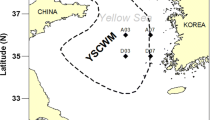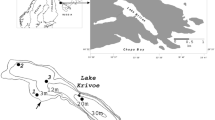Abstract
Carbon and nitrogen stable isotope ratios in tissue of the bivalve corbicula Corbicula japonica and particulate organic matter (POM) were measured in Lake Jusan, Lake Ogawara and Lake Shinji, which are the foremost fishing grounds for the corbicula in Japan, to determine their food sources. The bivalves in Lake Ogawara and Lake Shinji showed enriched isotope composition, while those in Lake Jusan were depleted. In addition, the difference in the isotope ratios between the sampling sites was remarkable in Lake Jusan. Chlorophyll concentrations were significantly higher in Lake Ogawara and Lake Shinji than those in the inflow rivers, although that in Lake Jusan was equivalent to that in the river. Residence time of river water was estimated at 1 day, 455 days and 88 days in Lake Ogawara and Lake Shinji assimilate autochthonous phytoplankton, while those in Lake Jusan assimilate terrestrial matter in the upper reaches and marine phytoplankton in the lower reaches because of low production in the lake.
Similar content being viewed by others
References
Nakamura M, Yamamuro M, Ishikawa M, Nishimura H. Role of the bivalve Corbicula japonica in the nitrogen cycle in a mesohaline lagoon. Mar. Biol. 1988; 99: 369–374.
Yamamuro M, Koike I. Nitrogen metabolism of the filterfeeding bivalve Corbicula japonica and its significance in primary production of a brackish lake in Japan. Limnol. Oceanogr. 1993; 38: 997–1007.
Hawkins AJS, Bayne BL, Clarke KR. Co-ordinated rhythms of digestion, absorption and excretion in Mytilus edulis (Bivalvia: Mollusca). Mar. Biol. 1983; 74: 41–48.
DeNiro MJ, Epstein S. Influence of diet on the distribution of carbon isotopes in animals. Geochim. Cosmochim. Acta 1978; 42: 495–506.
Fry B, Sherr EB. σ13 C measurements as indicators of carbon flow in marine and freshwater ecosystem. Contrib. Mar. Sci. 1984; 27: 13–47.
Kasai A, Nakata A. Utilization of terrestrial organic matter by the bivalve Corbicula japonica estimated from stable isotope analysis. Fish. Sci. 2005; 71: 151–158.
Murakami T. Potamoplanktonic algae. In: Saijo Y, Okuda S (eds). Tidal Rivers — Their Natural State and Human-Induced Changes. Nagoya University Press, Nagoya. 1996; 123–150.
Fuji A, Nakao S, Takano K. Environment and biological production in Lake Jusan. Reports on the Possible Development of Inland Fisheries in Lake Jusan (Environments and Biological Production in Lake Jusan). Aomori Prefecture, Aomori. 1976; 1–41.
Aomori Prefectural Fisheries Research Center Inland Water Fisheries Institute. Reports on the corbicula survey in 2003 (Lake Ogawara and Lake Jusan). Aomori Prefecture, Aomori, 2004.
Shimane Prefectural Inland Fisheries Experimental Station. Research reports of Shimane Prefectural Inland Fisheries Experimental Station in 2002. Shimane Prefecture, Matsue, 2003.
Nakamura M, Shinagawa A, Toda K, Nakao S. Tolerance to low concentrations of dissolved oxygen of Corbicula Japonica. Suisanzoshoku 1997; 45: 9–15.
Yokoyama H, Ishihi Y. Feeding of the bivalve Theora lubrica on benthic microalgae: isotopic evidence. Mar. Ecol. Prog. Ser. 2003; 255: 303–309.
Cahoon LB, Cooke JE. Benthic microalgal production in Onslow Bay, North-Carolina, USA. Mar. Ecol. Prog. Ser. 1992; 84: 185–196.
Jahnke RA, Nelson JR, Marinelli RL, Eckman JE. Benthic flux of biogenic elements on the southeastern US continental shelf: influence of pre water advective transport and benthic microalgae. Cont. Shelf Res. 2000; 20: 109–127.
Japan Meteorological Agency. Manual on oceanographic observation. 1970; 253–254.
Infrastructure Development Institute of Japan. Rivers in Japan. [Cited 7 November 2005.] Available from URL: http://www.japanriver.or.jp/
Ishikawa T. Fluid dynamics in Lake Ogawara related to the propagation of Corbicula Japonica. Nagare 2001; 20: 346–353.
Nakamura Y. Numerical analysis in a lake in which bivalves are dominant. Proc. Coast. Engineer. 2002; 49: 1031–1035.
Unoki S. Physical Oceanography in Coastal Areas. Tokai University Press, Tokyo. 1995.
Tohoku Regional Bureau, Ministry of Land, Infrastructure and Transport. Water environment for Takse River and Lake Ogawara. [Cited 7 November 2005.] Available from URL: http://www.thr.mlit.go.jp/takase/mizu/5-3.html
Yamamuro M. Water purification techniques using the food chain. Chishitsu News 1997; 520: 34–41.
Wada E, Minagawa M, Mizutani H, Tsuji T, Imaizumi R, Karasawa K. Biogeochemical studies on the transport of organic matter along the Otsuchi River watershed, Japan. Estuar. Coast. Shelf Sci. 1987; 25: 321–336.
Ogawa N, Ogura N. Dynamics of particulate organic matter in the Tamagawa estuary and inner Tokyo Bay. Estuar. Coast. Shelf Sci. 1997; 44: 263–273.
Yamada Y, Ueda T, Wada E. Distribution of carbon and nitrogen isotope ratios in the Yodo River watershed. Jpn. J. Limnol. 1996; 57: 467–477.
Incze LS, Mayer LM, Sherr EB, Macko SA. Carbon inputs to bivalve mollusks: a comparison of two estuaries. Can. J. Fish. Aquat. Sci. 1982; 39: 1348–1352.
Couch CA. Carbon and nitrogen stable isotopes of meiobenthos and their food resources. Estuar. Coast. Shelf Sci. 1989; 28: 433–441.
Riera P, Richard P, Gremare A, Blanchard G. Food source of intertidal nematodes in the Bay of Marennes-Oleron (France), as determined by dual stable isotope analysis. Mar. Ecol. Prog. Ser. 1996; 142: 303–309.
Riera P, Richard P. Temporal variation of σ13C in particulate organic matter and oyster Crassostrea gigas in Marennes-Oleron Bay (France): effect of fresh water inflow. Mar. Ecol. Prog. Ser. 1997; 147: 105–115.
Riera P, Richard P. Determination of food sources for benthic invertebrates in a salt marsh (Aiguillon Bay, France) by carbon and nitrogen stable isotopes: importance of locally produced sources. Mar. Ecol. Prog. Ser. 1999; 187: 301–307.
Yamamuro M. Chemical tracers of sediment organic matter origins in two coastal lagoons. J. Mar. Sys. 2000; 26: 127–134.
Kasai A, Horie H, Sakamoto W. Selection of food sources by Ruditapes philippinarum and Mactra veneriformis (Bivalva: Mollusca) determined from stable isotope analysis. Fish. Sci. 2004; 70: 11–20.
Cifuntes LA, Sharp JH, Fogel ML. Stable carbon and nitrogen istope biogeochemistry in the Delaware estuary. Limno. Oceanogr. 1988; 33: 1102–1115.
Minagawa M, Wada E. Stepwise enrichment of 15N along food chains: further evidence and the relation between σ15N and animal age. Geochim. Cosmochim. Acta 1984; 48: 1135–1140.
Dauby P. The stable carbon isotope ratios in benthic food webs of the Gulf of Calvi, Corsica. Cont. Shelf Res. 1989; 9: 181–195.
Deegan LA, Garritt RH. Evidence for spatial variability in estuarine food webs. Mar. Ecol. Prog. Ser. 1997; 147: 31–47.
Lee SY. Carbon dynamics of Deep Bay, eastern Pearl River estuary, China. II. Trophic relationship based on carbon-and nitrogen-stable isotopes. Mar. Ecol. Prog. Ser. 2000; 205: 1–10.
Takai N, Mishima Y, Yorozu A, Hoshika A. Carbon sources for demersal fish in the western Seto Inland Sea, Japan examined by σ13C and σ15N analyses. Limno. Oceanogr. 2002; 47: 730–741.
Parsons TR, Takahashi M, Hargrave B. Biological Oceanographic Processes, Pergamon Press, Oxford. 1984.
Byrne KA, Lehnert SA, Johnson SE, Moore SS. Isolation of a cDNA encoding a putative cellulase in the red claw crayfish Cherax quadricarinatus. Gene 1999; 239: 317–324.
Xu B, Janson J-C, Sellos D. Cloning and sequencing of a molluscan endo-ß-1,4-glucanase from the blue mussel, Mytilus edulis. Eur. J. Biochem. 2001; 268: 3718–3727.
Suzuki K, Ojima T, Nishita K. Purification and cDNA cloning of a cellulase from abalone Haliotis Discus Hannai. Eur. J. Biochem. 2003; 270: 771–778.
Author information
Authors and Affiliations
Corresponding author
Rights and permissions
About this article
Cite this article
Kasai, A., Toyohara, H., Nakata, A. et al. Food sources for the bivalve Corbicula japonica in the foremost fishing lakes estimated from stable isotope analysis. Fish Sci 72, 105–114 (2006). https://doi.org/10.1111/j.1444-2906.2006.01123.x
Received:
Accepted:
Issue Date:
DOI: https://doi.org/10.1111/j.1444-2906.2006.01123.x




